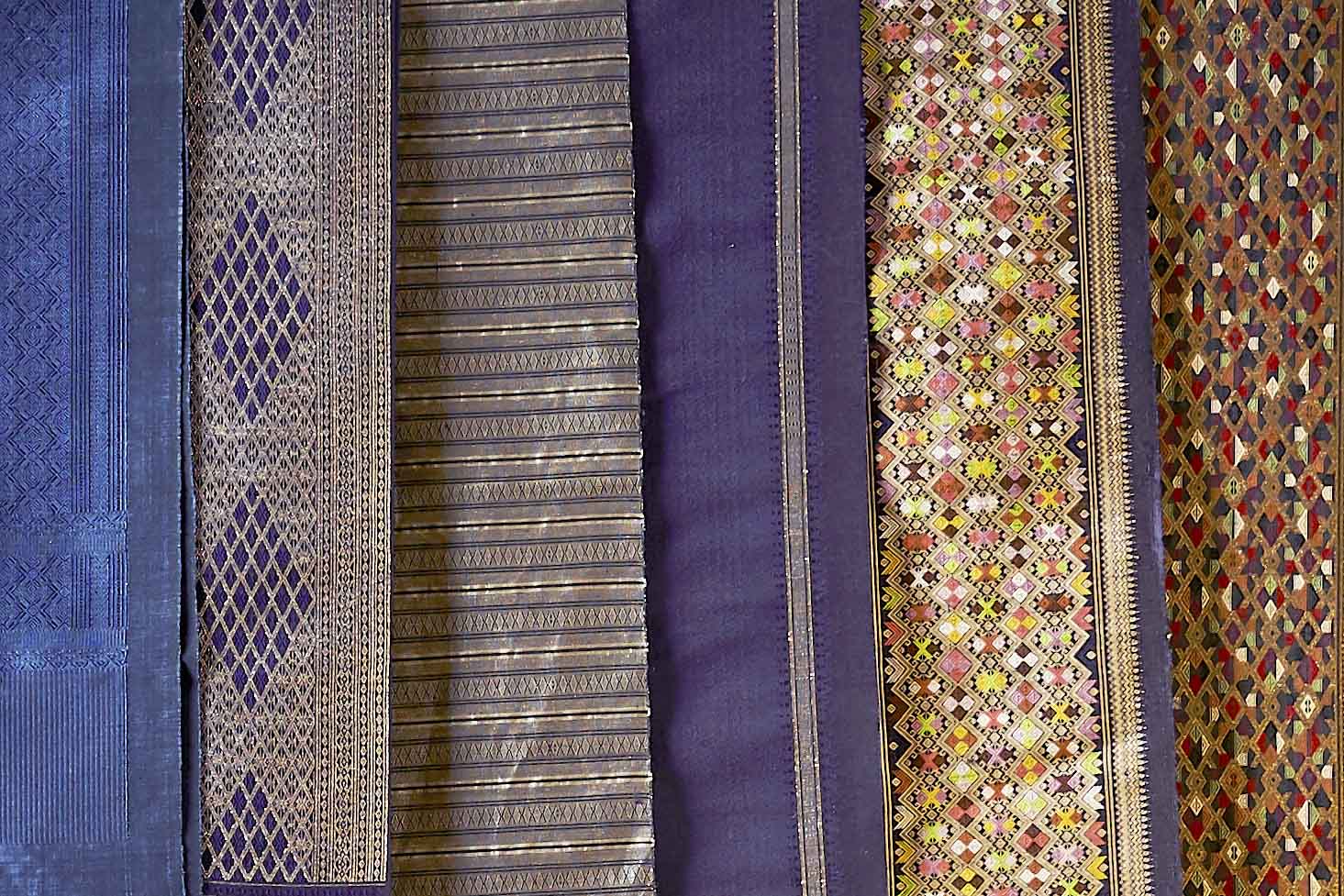ຍ້ອນເບິ່ງຄືນອະດີດເພື່ອຄົ້ນຫາອະນາຄົດຜ່ານຜືນຜ້າລາວ
ຮ້ານ ອຸດອນ ຜ້າໄໝ (Oudone Precious Silk), ເປັນຮ້ານຜ້າໄໝທີ່ມີຊື່ສຽງອີກແຫ່ງໜຶ່ງໃນນະຄອນຫຼວງວຽງຈັນ, ໃນນາມຜູ້ປະດິດເຄື່ອງນຸ່ງຫົ່ມທີ່ເຮັດຈາກຜ້າໄໝທີ່ມີຄຸນນະພາບສູງ ໂດຍອີງໃສ່ຄວາມຮູ້ ແລະ ຄວາມງາມທີ່ເປັນມໍລະດົກສືບທອດຂອງລາວ, ຮ້ານດັ່ງກ່າວໄດ້ເປີດໃຫ້ບໍລິການໃນປີ 2001. ຮ້ານອຸດອນ ຜ້າໄໝ ແມ່ນທ່ານ ນາງ ອຸດອນ ພ້ອມລູກສາວຂອງເພິ່ນ ທ່ານ ນາງ ວານິດາ ເປັນຜູ້ສ້າງຂຶ້ນ, ເຊິ່ງທັງສອງເຄີຍອາໄສຢູ່ປະເທດຝຣັ່ງເປັນເວລາຫຼາຍສິບປີ. ມາຮອດປີ 1989, ທ່ານ ນາງ ອຸດອນ ໄດ້ເດີນທາງກັບຄືນສູ່ນະຄອນຫຼວງວຽງຈັນກ່ອນ ແລະ ໃນປີ 2012 ທ່ານ ນາງ ວານິດາ ກໍໄດ້ກັບຄືນສູ່ນະຄອນຫຼວງວຽງຈັນເຊັ່ນກັນ, ນັບແຕ່ນັ້ນເປັນຕົ້ນມາ ທັງສອງໄດ້ພ້ອມກັນຕັ້ງໃຈອອກແບບເຄື່ອງນຸ່ງຫົ່ມແບບຮ່ວມສະໄໝຢ່າງຕັ້ງໜ້າ ຂະນະທີ່ຍັງດໍາເນີນການປະດິດສິນຄ້າທີ່ເປັນຜະລິດຕະພັນແບບດັ້ງເດີມຂອງລາວ ໂດຍສະເພາະກໍແມ່ນສິ້ນ, ເຊິ່ງເປັນສິ້ນໄໝທີ່ແມ່ຍິງລາວທົ່ວປະເທດໃຫ້ຄວາມນິຍົມ ບໍ່ວ່າຈະເປັນພະນັກງານລັດຖະກອນ ຫຼື ພະນັກງານຫ້ອງການທົ່ວໄປ ລວມທັງເຄື່ອງນຸ່ງຖືເພື່ອເຂົ້າຮ່ວມໃນພິທີທາງສາສະໜາພຸດ ເຊິ່ງເປັນສາສະໜາປະຈຳຊາດຂອງລາວ. ຜະລິດຕະພັນດັ່ງກ່າວໄດ້ຮັບການປະດິດແບບຮ່ວມສະໄໝ ລະຫວ່າງລາວ ແລະ ຝຣັ່ງ ເຊິ່ງປະກົດໃຫ້ເຫັນໃນລັກສະນະທີ່ເປັນທໍາມະຊາດສະທ້ອນຜ່ານຄໍເລັກຊັ່ນທີ່ນຳໃຊ້ເສັ້ນໄໝສີຄຳເປັນອົງປະກອບທີ່ສຳຄັນໃນການຕໍ່າຜືນຜ້າ. ເສັ້ນໄໝຄຳທີ່ປະກອບໃນຜືນຜ້າເຫຼົ່ານີ້ ແມ່ນຜະລິດໃນເມືອງລີຢົງ, ປະເທດຝຣັ່ງ ຖືເປັນງານສີມືຫັດຖະກຳທີ່ມີອາຍຸຫຼາຍສະຕະວັດ ທີ່ີມີຄວາມໂດດເດັ່ນໃນການຊື້ຂາຍແຜ່ນແພໃນຝຣັ່ງເສດ ແລະສ່ວນໃຫຍ່ແມ່ນບັນດາສະມາຊິກຄອບຄົວຂອງລາຊະວົງໃນລາວທີ່ນິຍົມນຸ່ງຖື.
ທ່ານ ນາງ ອຸດອນ ແລະ ທ່ານ ນາງ ວານິດາ ໄດ້ນຳໃຊ້ວິທີການປະດິດຜ້າໄໝລາວດ້ວຍການນຳເອົາຄວາມຮູ້ ແລະ ຄວາມສາມາດທາງດ້ານວັດທະນະທຳທີ່ສືບທອດມາແຕ່ບັນພະບູລຸດມາປະສົມປະສານຜ່ານການອອກແບບຮ່ວມສະໄໝ ແຕ່ກໍຍັງຄົງຮັກສາຄວາມເປັນວັດທະນະທຳລາວແບບດັ້ງເດີມເອົາໄວ້ເພື່ອເປັນຊັບສົມບັດໃຫ້ແກ່ຄົນຮຸ່ນໃໝ່ໄດ້ສືບທອດຕໍ່ໄປ.
“ພວກເຮົາລ້ວນແຕ່ປາຖະໜາໃຫ້ການຕໍ່າແຜ່ນແພນັ້ນຄົງຢູ່ຕະຫຼອດໄປໂດຍບໍ່ມີວັນເສື່ອມຄາຍ. ພວກເຮົາມີຕະຫຼາດຮອງຮັບສິນຄ້າສະເພາະກຸ່ມ ແລະ ຈະຜະລິດຕາມຈໍານວນການສັ່ງຊື້ເທົ່ານັ້ນ ເພື່ອຮັບປະກັນໃຫ້ຜະລິດຕະພັນຂອງພວກເຮົາມີເອກະລັກສະເພາະໃນຕົວມັນເອງ. ລູກຄ້າຂອງພວກເຮົາສ່ວນໃຫຍ່ຈະແມ່ນບັນດານັກສະສົມ ແລະ ຄົນລາວທີ່ດໍາລົງຊີວິດຢູ່ຕ່າງປະເທດ ຜູ້ທີ່ມີຄວາມເປັນຫ່ວງເປັນໃຍຕໍ່ສະພາບແວດລ້ອມທາງວັດທະນະທໍາຂອງພວກຕົນ. ເມື່ອກ່ອນລູກຄ້າຄົນລາວຂອງພວກເຮົາແມ່ນມີຫຼາຍພໍສົມຄວນ, ແຕ່ດ້ວຍໄວອາຍຸທີ່ນັບມື້ນັບເພີ່ມຂຶ້ນ ເຮັດໃຫ້ຈໍານວນລູກຄ້າດັ່ງກ່າວຄ່ອຍຫຼຸດລົງເທື່ອລະໜ້ອຍ. ຈຸດພິເສດອັນພົ້ນເດັ່ນຂອງຜະລິດຕະພັນຂອງພວກເຮົາກໍແມ່ນ “ຄວາມປານີດ” ທີ່ພວກເຮົາສ້າງຂຶ້ນດ້ວຍເອກະລັກທີ່ແຕກຕ່າງບໍ່ຄືໃຜ ແລະ ພະຍາຍາມທີ່ຈະເຮັດໃຫ້ມັນແຕກຕ່າງຢ່າງສ້າງສັນທ່າມກາງການແຂ່ງຂັນທາງດ້ານການຕະຫຼາດທີ່ນັບມື້ນັບສູງຂຶ້ນ. ພວກເຮົາເຊື່ອວ່າ ຄວາມງາມທີ່ມີເອກະລັກແບບດັ້ງເດີມຂອງລາວ ຈະກາຍເປັນສັກກາຍະພາບອັນແຂງແກ່ນໃນການຊ່ວຍໃຫ້ແຟຊັ່ນຮ່ວມສະໄໝທີ່ພວກເຮົາສ້າງຂຶ້ນມານັ້ນ ມີເອກະລັກສະເພາະຕົວ. ນັກອອກແບບຄົນລາວ ຈະຕ້ອງມີຄວາມພິຖີພິຖັນຢ່າງລະອຽດຮອບຄອບໃນການຕັດຫຍິບແຜ່ນແພແຕ່ລະຊິ້ນ ພ້ອມໃສ່ໃຈໃນລາຍລະອຽດເປັນອັນດັບທຳອິດ.

ການລອກຮຽນແບບຂອງບັນດາໂຮງງານຜະລິດແຜ່ນແພຕ່າງໆນັ້ນ ອາດເປັນການທໍາລາຍງານສີມືຫັດຖະກໍາຂອງພວກເຮົາ, ລວມທັງຄວາມຖືກຕ້ອງ ແລະ ຄວາມເປັນເອກະລັກສະເພາະຕົວຂອງມັນໄດ້. ຂະແໜງຫັດຖະກໍາ ຖືເປັນແຫຼ່ງລາຍຮັບທີ່ສໍາຄັນສໍາລັບແມ່ຍິງ, ເຊິ່ງສາມາດຍົກລະດັບຊີວິດການເປັນຢູ່ຂອງພວກເຂົາໄດ້ເປັນຢ່າງດີ. ສິນຄ້າລອກຮຽນແບບທີ່ຜະລິດຈາກໂຮງງານ ມີຄ່າສະເພາະລາຄາທີ່ຕີເປັນເງິນເທົ່ານັ້ນ ແຕ່ບໍ່ໄດ້ໃຫ້ຄວາມສໍາຄັນຫຍັງຕໍ່ການຮັກສາຄຸນຄ່າທີ່ເປັນເອກະລັກທາງວັດທະນະທໍາ. ພວກເຮົາຕ້ອງການກໍານົດກຸ່ມເປົ້າໝາຍ ແລະ ສ້າງແຮງບັນດານໃຈໃນການສົ່ງເສີມຕະຫຼາດໃນທ້ອງຖິ່ນ ເນື່ອງຈາກຄົນລາວສ່ວນໃຫຍ່ຍັງນິຍົມໃຊ້ເຄື່ອງນຸ່ງຫົ່ມທີ່ຜະລິດຈາກຜ້າໄໝແບບດັ້ງເດີມເປັນປະຈໍາ. ພວກເຮົາຍັງປາຖະໜາຢາກໃຫ້ມີໂຮງຮຽນສອນຕໍ່າຫູກ ຫຼື ສູນການອອກແບບເພື່ອອະນຸລັກຮັກສາຄວາມຮູ້ຄວາມຊໍານານ, ວິທີການຕ່າງໆ, ແລະ ສ້າງຄວາມຮ່ວມມືລະຫວ່າງນັກອອກແບບທັງພາຍໃນ ແລະ ຕ່າງປະເທດ. ພວກເຮົາຈໍາເປັນຕ້ອງໄດ້ເສີມສ້າງຄວາມຮູ້ຄວາມເຂົ້າໃຈ ແລະ ຄວາມຊື່ນຊົມຍິນດີຕໍ່ວັດທະນະທໍາຕໍ່າແຜ່ນຂອງພວກເຮົາເພື່ອກ້າວໄປສູ່ອະນາຄົດ.”
ໃນຍຸກສະໄໝທີ່ສັງຄົມມີການເຊືອມໂຍງຫຼາຍມິຕິ ແລະ ມີຄວາມປະສົມປະສານທີ່ຫຼາກຫຼາຍໃນທົ່ວພາກພື້ນ, ຮີດຄອງປະເພນີ ແລະ ຊັບສິນທີ່ເປັນມໍລະດົກຕົກທອດມາແຕ່ບັນພະບູລຸດ ຈໍາເປັນຕ້ອງໄດ້ຮັບການພິຈາລະນາໃໝ່ດ້ວຍມຸມມອງໃໝ່ ແລະ ຄວນມີການເປີດໃຈທີ່ກວ້າງຂຶ້ນ. ອີກດ້ານໜຶ່ງນັ້ນກໍຄື ການສ້າງຄວາມເຂົ້າໃຈເຖິງວິທີການທີ່ຊຸມຊົນຕ່າງໆໄດ້ທຸ້ມເທຄວາມທະເຍີທະຍານທາງວັດທະນະທໍາ ແລະ ຄວາມຄິດສ້າງສັນຂອງຕົນເອງເພື່ອເຮັດໃຫ້ຜົນງານອອກມາເປັນທີ່ຍອມຮັບຂອງສັງຄົມ, ຂະນະທີ່ອີກດ້ານໜຶ່ງກໍຄືການວິເຄາະກ່ຽວກັບຮີດຄອງປະເພນີທີ່ຍັງຄົງມີຢູ່ຜ່ານການດໍາລົງຊີວິດແບບຮ່ວມສະໄໝ. ຮູບແບບການຕັດຫຍິບເພື່ອປະກອບຫຼາຍຊິ້ນສ່ວນເຂົ້າໃສ່ກັນ, ລວມທັງການປະສົມປົນເປກັນລະຫວ່າງຂອງແທ້ກັບຂອງລອກຮຽນແບບ, ສິ່ງເກົ່າແກ່ ແລະ ສິ່ງໃໝ່, ທັງທ້ອງຖິ່ນ ແລະ ສາກົນ ຖືເປັນຂະບວນການທີ່ມີລັກສະນະທີ່ເປັນທໍາມະຊາດ ແລະ ບາງຄັ້ງກໍເກີດມີຄວາມຂັດແຍ່ງກັນ. ຜົນງານທີ່ໄດ້ຮັບການພັດທະນາຂຶ້ນເລື້ອຍໆນີ້ ຖືກຕັ້ງຢູ່ໃນການລວມເຂົ້າກັນລະຫວ່າງມໍລະດົກ ແລະ ວັດທະນະທໍາສະໄໝນິຍົມ, ແລະເປັນແວ່ນແຍງທີ່ອາດສະທ້ອນເຖິງຄຸນລັກສະນະທີ່ແທ້ຈິງຂອງວັດທະນະທໍາທີ່ຍັງຄົງຢູ່ໃນອາຊີໃນປະຈຸບັນ.

ຜືນຜ້າລາວບໍ່ໄດ້ເປັນພຽງວັດຖຸສິ່ງຂອງທີ່ນຳໃຊ້ເພື່ອນຸ່ງຫົ່ມເຂົ້າໃນພິທີທີ່ເປັນທາງການ ຫຼື ວຽກງານສໍາຄັນໃດໜຶ່ງເທົ່ານັ້ນ, ເຄື່ອງນຸ່ງຫົ່ມແບບດັ້ງເດີມທີ່ເຮັດດ້ວຍຜ້າໄໝຈໍານວນຫຼາຍ ຍັງໄດ້ຖືກປ່ຽນໃຫ້ກາຍເປັນຜະລິດຕະພັນແຫ່ງປະສົບການທີ່ມີເປົ້າໝາຍ ເພື່ອເຂົ້າເຖິງກຸ່ມລູກຄ້າທີ່ກວ້າງຂຶ້ນ. ການເຂົ້າເຖິງເຕັກໂນໂລຢີການສື່ສານ ແລະ ສັງຄົມອອນລາຍທີ່ນັບມື້ນັບກວ້າງຂວາງ ໄດ້ເປັນຕົວນໍາພາໃຫ້ຊັບສິນທີ່ເປັນມໍລະດົກດັ່ງກ່າວ ເຕີບໃຫຍ່ຂະຫຍາຍຕົວພ້ອມກ້າວໄປສູ່ຫຼາຍລະດັບ ເຊິ່ງລວມມີ ການຮັບຮູ້ທາງດ້ານວັດທະນະທໍາ, ກະແສສັງຄົມ, ແລະ ການພັດທະນາເສດຖະກິດນໍາອີກ.
ສື່ອອນລາຍໄດ້ເປັນເຄື່ອງມືນໍາສະເໜີສິ່ງໃໝ່ໆໃນການຮັບຮູ້ທາງວັດທະນະທໍາ, ລວມທັງການສະໜັບສະໜູນບັນດາຊຸມຊົນກຸ່ມນ້ອຍ ຫຼື ສົ່ງເສີມແບຣນສິນຄ້າຂອງປະເທດຕົນ. ຂະນະທີ່ລະຄອນໂທລະພາບ ໂດຍສະເພາະກໍແມ່ນລະຄອນເກົາຫຼີ ແລະ ໄທ ກໍໄດ້ເປັນສື່ກາງປຸກກະແສຄວາມສົນໃຈຕໍ່ເຄື່ອງນຸ່ງຫົ່ມແບບດັ້ງເດີມຂອງປະເທດຕົນ ໂດຍກາຍເປັນກະແສນິຍົມໃນກຸ່ມຄົນທ້ອງຖິ່ນ ແລະ ຄົນຕ່າງປະເທດ ຈິ່ງເຮັດໃຫ້ເກີດມີການປະສົມປະສານທາງວັດທະນະທໍາແບບໃໝ່ຂຶ້ນ. ແພລດຟອມດິຈິຕອນ ຍັງເປັນເຄື່ອງມືໃນການປ່ຽນແປງຊີວິດໃຫ້ແກ່ກຸ່ມຊົນເຜົ່າບາງກຸ່ມ ທີ່ກໍາລັງຂະຫຍາຍທຸລະກິດຜືນຜ້າທີ່ຕໍ່າດ້ວຍມື ຜ່ານການເປີດກວ້າງ ແລະ ຄວາມຕ້ອງການຂອງລູກຄ້າທາງອອນລາຍ.
ທ່ານ ນາງ ວານິດາ ພິມພະຈັນ ເຈົ້າຂອງຮ້ານອຸດອນ ຜ້າໄໝ
Sali Sasaki ແມ່ນທີ່ປຶກສາ ແລະ ນັກຄົ້ນຄວ້າດ້ານຄວາມຄິດສ້າງສັນ. ສາມາດຕິດຕາມການບັນທຶກ, ເລື່ອງເລົ່າ, ແລະ ການສໍາຫຼວດຕ່າງໆຈາກອາຊີຂອງນາງໄດ້ທີ່ salisasaki.com
ບົດນີ້ດັດມາຈາກ “Patchworks: the Globalized Life of Traditional Clothes in East Asia” ທີ່ຮັບການອຸປະຖຳໂດຍ The Asia Culture Center ຢູ່ ສ. ເກົາຫຼີ.

ຂໍ້ມູນເພີ່ມເຕີມ
ສາມາດເຂົ້າເບິ່ງ ອຸດອນ ຜ້າໄໝ ໄດ້ທີ່ oudone.com ຫຼື ເດີນທາງໄປທີ່ຮ້ານ ອຸດອນ ຜ້າໄໝ ໄດ້ທີ່ນະຄອນຫຼວງວຽງຈັນ.
ວິທີການເດີນທາງ
ສາຍການບິນລາວມີຖ້ຽວບິນປະຈໍາຈາກນະຄອນຫຼວງວຽງຈັນເພື່ອເດີນທາງໄປແຂວງຕ່າງໆໃນລາວ.
ແປ ແລະ ຮຽບຮຽງໂດຍ ໄພບູນ ທະນະບົວສີ



 English
English
